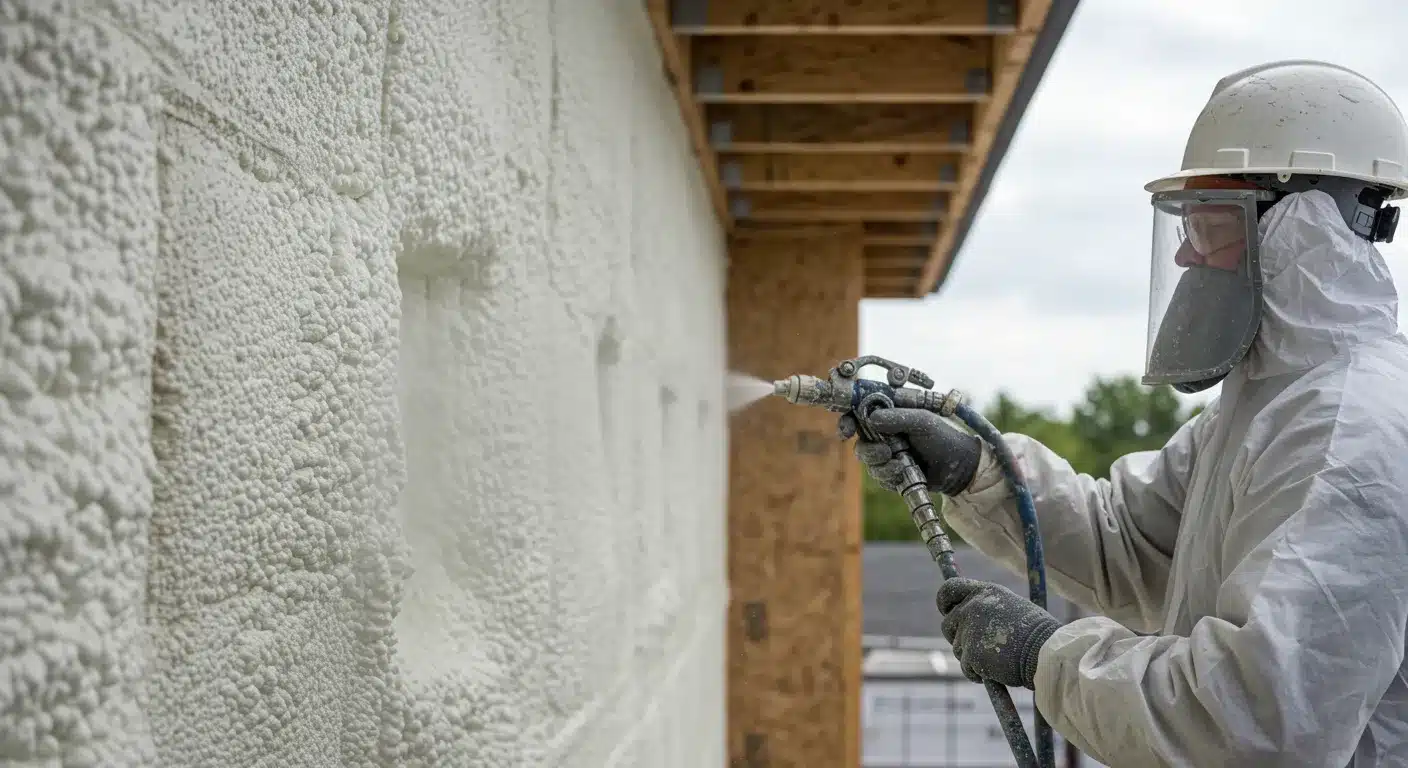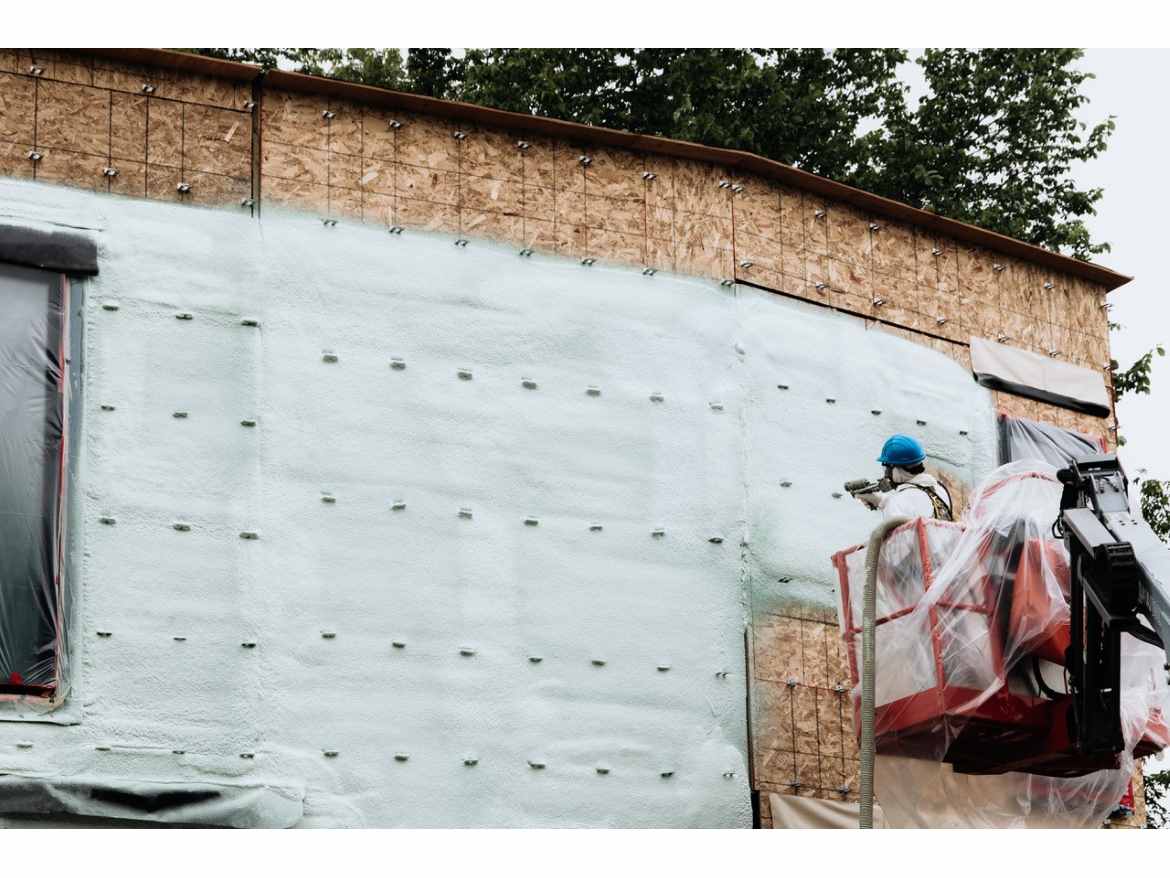Exterior insulation creates a continuous thermal barrier that prevents heat transfer through structural elements, reducing energy consumption by 20-40% in most climates. This approach eliminates thermal bridging through studs, joists, and other building components that would otherwise conduct heat between indoor and outdoor environments.
Adding insulation to a building’s exterior rather than between structural members delivers superior performance by creating an uninterrupted thermal envelope. This method works effectively in all climate zones by keeping heat inside during cold weather and outside during warm weather, while simultaneously reducing moisture problems and improving indoor comfort.
Types of Exterior Insulation Systems
Different exterior insulation materials and systems offer varying benefits depending on climate conditions and building design requirements.
Rigid Foam Boards
Rigid foam insulation panels attach directly to exterior walls before finishing materials. These boards come in various materials with different performance characteristics.
| Material | R-Value per inch | Moisture Resistance | Cost Range | Best Climate Applications |
| Expanded Polystyrene (EPS) | 3.6-4.2 | Moderate | $0.25-0.40/sq ft/inch | All-climate, budget-friendly option |
| Extruded Polystyrene (XPS) | 4.5-5.0 | High | $0.42-0.65/sq ft/inch | Cold, wet climates |
| Polyisocyanurate (ISO) | 5.6-6.5 | Moderate | $0.70-1.00/sq ft/inch | Hot climates (R-value decreases in cold) |
| Mineral Wool Boards | 3.7-4.2 | Excellent | $0.60-0.95/sq ft/inch | Fire-prone areas, all climates |
Bonus Tip: When installing rigid foam, always stagger the joints between panels to prevent thermal leaks and use construction tape specifically designed for exterior applications to seal all seams.
Exterior Insulation and Finish Systems (EIFS)
EIFS combines insulation with protective outer layers to create a complete exterior wall system.
The system typically includes an adhesive layer attached to substrate, rigid insulation (usually EPS), reinforcing mesh embedded in base coat, and finish coat with color and texture.
EIFS provides excellent energy efficiency with an uninterrupted insulation layer and built-in air/water barriers. Market data shows EIFS installations have increased by 27% in residential retrofits over the past five years as homeowners seek energy-efficient upgrades.
Insulated Vinyl Siding
This option combines traditional vinyl siding with rigid foam backing, offering both aesthetic appeal and improved insulation.
| Feature | Standard Vinyl Siding | Insulated Vinyl Siding |
| R-Value | 0.61 | 2.0-3.5 |
| Impact Resistance | Low-Moderate | High |
| Noise Reduction | Minimal | Moderate |
| Installation Complexity | Simple | Moderate |
| Cost Premium | Baseline | 15-30% higher |
| Lifespan | 20-30 years | 30-40 years |
How Exterior Insulation Performs in Different Climates
Exterior insulation delivers unique benefits in various climate conditions when properly selected and installed.
Cold Climates
In cold regions, exterior insulation:
- Moves the dew point outside the wall structure, preventing condensation within walls
- Maintains higher interior surface temperatures, improving comfort
- Reduces heat loss through thermal bridging by up to 65%
- Protects structural elements from freeze-thaw damage
Hot, Humid Climates
For warm, moisture-prone areas, exterior insulation:
- Blocks solar heat gain before it reaches structural elements
- Reduces cooling load by keeping thermal mass cooler
- Can incorporate rainscreen systems to manage moisture
- Prevents humidity infiltration when combined with proper air barriers
Mixed Climates
In regions with significant seasonal variation, exterior insulation:
- Provides year-round benefits by addressing both heating and cooling needs
- Creates better temperature stability through changing conditions
- Reduces HVAC cycling, extending equipment life
Energy Efficiency Performance Metrics
Research data consistently shows the measurable benefits of exterior insulation across building types.
| Performance Metric | Typical Improvement with Exterior Insulation | Notes |
| Annual Energy Savings | 20-40% | Varies by climate and existing conditions |
| Thermal Bridging Reduction | 65-95% | Compared to interior-only insulation |
| Air Leakage Reduction | 30-50% | When combined with proper air sealing |
| Temperature Stability | ±2°F vs. ±8°F | Daily temperature fluctuation |
| HVAC Sizing Reduction | 15-25% | Smaller equipment requirements |
| Payback Period | 3-10 years | Climate-dependent |
Things to Consider Before Making a Decision
Building Structure Assessment
Evaluate your building’s structure before proceeding: wall construction type and structural integrity, existing moisture issues that need addressing, window and door conditions (may need extension jambs), roof overhangs (may need extension), and foundation details and how insulation will connect.
Code and Permit Requirements
Local building codes impact exterior insulation projects: R-value minimums for your climate zone, fire rating requirements for exterior materials, historic district restrictions or architectural guidelines, and setback requirements that might be affected by added wall thickness.
Bonus Tip: Many jurisdictions offer expedited permitting or incentives for energy-efficient renovations. Check with your local building department and utility companies for potential rebates or tax incentives before beginning your project.
Cost-Benefit Analysis
Consider these financial factors: initial installation cost ($5-$15 per square foot depending on system), energy savings potential based on your climate and utility rates, property value increase (typically 70% return on investment), maintenance requirements and long-term durability, and potential for combining with other needed exterior repairs.
Installation Process Overview
Proper installation is critical for exterior insulation performance:
- Preparation: Remove obstacles, repair damage, address moisture issues
- Air/Water Barrier: Apply house wrap or liquid-applied membrane
- Insulation Installation: Attach rigid boards with proper fasteners
- Sealing: Tape joints and seal penetrations
- Attachment System: Install furring strips or specialized anchors for cladding
- Cladding Installation: Apply finish material according to manufacturer specs
A recent industry survey found that 87% of installation failures were traced to improper flashing and sealing around penetrations, making this step particularly crucial for long-term performance.
Bonus Tip: When installing exterior insulation, always work from the bottom up and ensure proper integration with existing flashing at windows, doors, and roof connections to prevent water intrusion.
Common Questions
Can I install exterior insulation myself?
While DIY installation is possible for experienced homeowners, exterior insulation systems require precise installation to perform correctly. Improper installation can lead to moisture problems, reduced efficiency, and premature failure. Most homeowners benefit from professional installation, particularly for complex systems like EIFS.
How thick should exterior insulation be?
The optimal thickness depends on your climate zone, existing wall construction, and energy efficiency goals. In general:
- Cold climates (Zones 5-8): 2-4 inches (R-10 to R-20)
- Mixed climates (Zones 3-4): 1-3 inches (R-5 to R-15)
- Hot climates (Zones 1-2): 1-2 inches (R-5 to R-10)
What happens to windows and doors when adding exterior insulation?
Window and door openings require special treatment when installing exterior insulation. Options include:
- Extension jambs to accommodate the new wall thickness
- “Innie” installation where windows are repositioned to align with the insulation layer
- “Outie” installation where windows remain at the original position with insulation wrapping into the opening
Will exterior insulation cause moisture problems?
Properly installed exterior insulation actually improves moisture management by:
- Moving the dew point outside the structural wall
- Reducing thermal bridging that can cause condensation
- Creating a temperature buffer that minimizes condensation risk
However, poor installation or improper flashing can trap moisture. Always ensure proper water management details are included in your system design.
FAQ
Does exterior insulation work better than cavity insulation?
Exterior insulation provides superior performance because it eliminates thermal bridging through structural members. While cavity insulation remains important, combining it with exterior insulation delivers the best results, often improving energy efficiency by 30-40% compared to cavity insulation alone.
How long does exterior insulation last?
Most exterior insulation systems have a lifespan of 30-50 years when properly installed and maintained. The actual lifespan depends on material choice, installation quality, climate exposure, and maintenance practices.
Can I add exterior insulation to any building?
Most buildings can benefit from exterior insulation, but certain factors may complicate installation:
- Historic buildings with architectural features that must be preserved
- Buildings with complex exterior details or numerous penetrations
- Properties with setback restrictions that limit added wall thickness
Will exterior insulation change how my building looks?
Exterior insulation does add thickness to walls, but finish options are virtually unlimited. Cladding can match existing aesthetics or create an entirely new look. Window and door details may require adjustment to maintain proportions.
Is exterior insulation worth the cost?
For most buildings, exterior insulation delivers excellent return on investment through:
- Reduced energy bills (typically 20-40% savings)
- Improved comfort and indoor air quality
- Extended building lifespan through better moisture management
- Increased property value
 Make the Right Decision
Make the Right Decision
Exterior supreme spray foam insulation provides superior energy efficiency by creating a continuous thermal envelope that eliminates heat transfer through structural elements. The system you choose should match your climate conditions, building structure, aesthetic goals, and budget considerations.
Evaluate your specific situation, including existing wall performance, climate challenges, and long-term energy goals. Consult with qualified professionals to design a system that addresses your particular needs while maximizing return on investment.
Reviewer:
Michael Carter reviewed this article using insight gained over 12 years in the spray foam business. His feedback focused on helping contractors reach new customers without overcomplicating their message.










